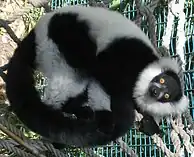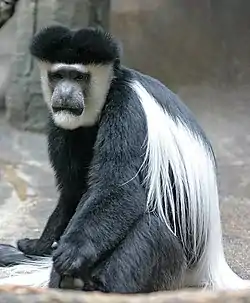Portal:Primates
The Primates Portal A primate is a member of the biological order Primates, the group that contains lemurs, the aye-aye, lorisids, galagos, tarsiers, monkeys, and apes, with the last category including great apes. With the exception of humans, who inhabit every continent on Earth, most primates live in tropical or subtropical regions of the Americas, Africa and Asia. Primates range in size from the 30-gram (1 oz) pygmy mouse lemur to the 200-kilogram (440 lb) mountain gorilla. According to fossil evidence, the primitive ancestors of primates may have existed in the late Cretaceous period around 65 mya (million years ago), and the oldest known primate is the Late Paleocene Plesiadapis, c. 55–58 mya. Molecular clock studies suggest that the primate branch may be even older, originating in the mid-Cretaceous period around 85 mya. Primates exhibit a wide range of characteristics. Some primates do not live primarily in trees, but all species possess adaptations for climbing trees. Locomotion techniques used include leaping from tree to tree, walking on two or four limbs, knuckle-walking, and swinging between branches of trees (known as brachiation). Primates are characterized by their large brains relative to other mammals. These features are most significant in monkeys and apes, and noticeably less so in lorises and lemurs. Many species are sexually dimorphic, which means males and females have different physical traits, including body mass, canine tooth size, and coloration.
Selected article
Ruffed lemurs are diurnal and arboreal quadrupeds, often observed leaping through the upper canopy of the seasonal tropical rainforests in eastern Madagascar. They are also the most frugivorous of the Malagasy lemurs, and they are very sensitive to habitat disturbance. Ruffed lemurs live in multi-male/multi-female groups and have a complex and flexible social structure, described as fission-fusion. They are highly vocal and have loud, raucous calls. (Full article...) Selected picture {{{caption}}} Emperor tamarins inhabit tropical rain forests, living deep in the forest and also in open tree-covered areas. This diurnal species walks or runs quadrupedally through the forest, spending the majority of its days in the trees with quick, safe movements and broad jumps among the limbs. CategoriesSelect [►] to view subcategories
Primates Lists of primates Primates by location Primate anatomy Primate behavior Primate conservation Evolution of primates Extinct primates Primate health Primates and humans Monkeys Primate taxa Primate stubs Selected species {{{caption}}}  Least Concern (IUCN 3.1)|Least Concern The mantled guereza (Colobus guereza), also known simply as the guereza, the eastern black-and-white colobus, or the Abyssinian black-and-white colobus, is a black-and-white colobus, a type of Old World monkey. It is native to much of west central and east Africa, including Cameroon, Equatorial Guinea, Nigeria, Ethiopia, Kenya, Tanzania, Uganda and Chad. It has a distinctive appearance which is alluded to in its name; the long white fringes of hair the run along each side of its black trunk are known as a mantle. Its face is framed with white hair and it has a large white tail tuft. The mantled guereza is diurnal and arboreal, found in both deciduous and evergreen forests. It is an adaptable species that can cope with habitat disturbance and prefers secondary forest close to rivers or lakes. Although previously thought only to eat leaves, it also eats seeds, fruits, and arthropods. It is able to digest plant material with a high fibre content with its specialised stomach and may only eat from a few plant species at a time. It is preyed on by birds of prey and some mammals such as the common chimpanzee and the leopard. The mantled guereza lives in social groups of three to fifteen individuals. These groups normally include a dominant male, several females, and the offspring of the females. It has a polygynous mating system. The mantled guereza is listed as Least Concern by the International Union for Conservation of Nature (IUCN) because it is widespread and although locally threatened in some areas the decline is not great enough to list it in a higher category of threat. However, one subspecies found in Kenya is listed as Endangered. Did you know?
Primate lists
WikiProjectsWikiProject Science
Things to do
Associated WikimediaDiscover Wikipedia using portals
|


